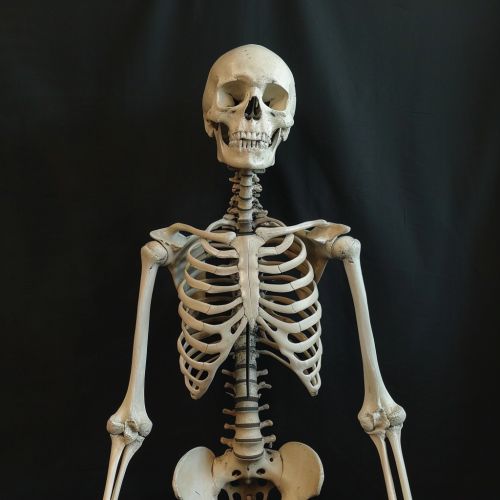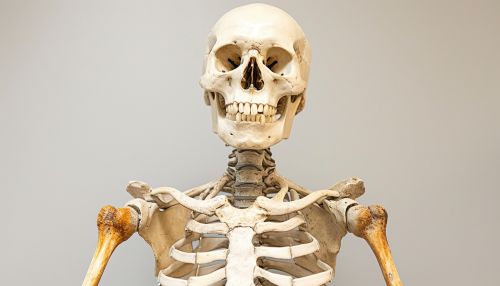Skeleton
Anatomy of the Skeleton
The human skeleton is a complex structure composed of 206 individual bones that provide support, protection, and mobility to the body. The skeleton is divided into two main parts: the axial skeleton and the appendicular skeleton. The axial skeleton consists of the skull, vertebral column, and thoracic cage, while the appendicular skeleton includes the bones of the upper and lower limbs, and the girdles that attach them to the axial skeleton.


Axial Skeleton
The axial skeleton forms the central axis of the body and is composed of 80 bones. It includes the skull, the vertebral column, and the thoracic cage.
Skull
The skull is a complex structure composed of 22 bones that house and protect the brain. It is divided into two parts: the cranium, which encloses the brain, and the facial bones, which form the face. The skull also includes the mandible, the only movable bone of the skull.
Vertebral Column
The vertebral column, or spine, is a flexible structure made up of 33 vertebrae. It provides support for the body, protects the spinal cord, and allows for a wide range of movement. The vertebral column is divided into five regions: the cervical, thoracic, lumbar, sacral, and coccygeal regions.
Thoracic Cage
The thoracic cage, or rib cage, is composed of 12 pairs of ribs, the sternum, and the thoracic vertebrae. It protects the heart, lungs, and other organs in the thoracic cavity.
Appendicular Skeleton
The appendicular skeleton is composed of 126 bones and includes the limbs and the girdles that attach them to the axial skeleton.
Upper Limbs
The upper limbs, or arms, consist of the humerus, radius, and ulna, along with the bones of the hand: the carpals, metacarpals, and phalanges.
Lower Limbs
The lower limbs, or legs, are composed of the femur, tibia, and fibula, as well as the bones of the foot: the tarsals, metatarsals, and phalanges.
Pectoral Girdle
The pectoral girdle, or shoulder girdle, connects the upper limbs to the axial skeleton. It is composed of two bones: the clavicle and the scapula.
Pelvic Girdle
The pelvic girdle, or hip girdle, connects the lower limbs to the axial skeleton. It is formed by two hip bones, each of which is made up of three fused bones: the ilium, ischium, and pubis.
Function of the Skeleton
The human skeleton serves several crucial functions in the body, including support, protection, movement, mineral storage, and blood cell production.
Support
The skeleton provides a rigid framework that supports the body and maintains its shape. The bones of the skeleton serve as attachment points for the muscles and ligaments of the body.
Protection
The skeleton protects the body's vital organs. For example, the skull protects the brain, the vertebral column protects the spinal cord, and the thoracic cage protects the heart and lungs.
Movement
The skeleton, in conjunction with the muscular system, enables movement. The joints between bones allow for a wide range of motion, and the muscles attached to the bones provide the force necessary for movement.
Mineral Storage
Bones serve as a reservoir for minerals, particularly calcium and phosphorus. These minerals are essential for various physiological processes and can be released into the bloodstream as needed.
Blood Cell Production
The marrow within certain bones, known as red marrow, is responsible for the production of blood cells, a process known as hematopoiesis.
Development of the Skeleton
The human skeleton begins to develop during the embryonic stage and continues to grow and change throughout life.
Embryonic Development
During embryonic development, the skeleton forms from mesenchymal tissue, which differentiates into cartilage and bone. This process, known as ossification, begins around the eighth week of embryonic development and continues into adulthood.
Growth and Remodeling
After birth, the skeleton continues to grow and remodel in response to physical stresses. This process is regulated by hormones, including growth hormone and sex hormones. The growth plates, or epiphyseal plates, located at the ends of the long bones, are responsible for the lengthening of the bones during childhood and adolescence.
Aging
With age, the human skeleton undergoes various changes. Bone density decreases, leading to an increased risk of fractures. The cartilage in the joints also wears down, which can lead to joint pain and stiffness.
Disorders of the Skeleton
There are many disorders that can affect the human skeleton, including fractures, osteoporosis, arthritis, and bone cancer.
Fractures
A fracture is a break in a bone. Fractures can occur as a result of trauma, such as a fall or a blow to the bone, or due to underlying conditions that weaken the bone, such as osteoporosis.
Osteoporosis
Osteoporosis is a condition characterized by low bone mass and deterioration of bone tissue, leading to increased bone fragility and risk of fracture.
Arthritis
Arthritis is a group of conditions that cause inflammation and damage to the joints. The most common types of arthritis are osteoarthritis and rheumatoid arthritis.
Bone Cancer
Bone cancer is a rare type of cancer that originates in the bone. It can occur in any bone in the body, but it most commonly affects the long bones in the arms and legs.
